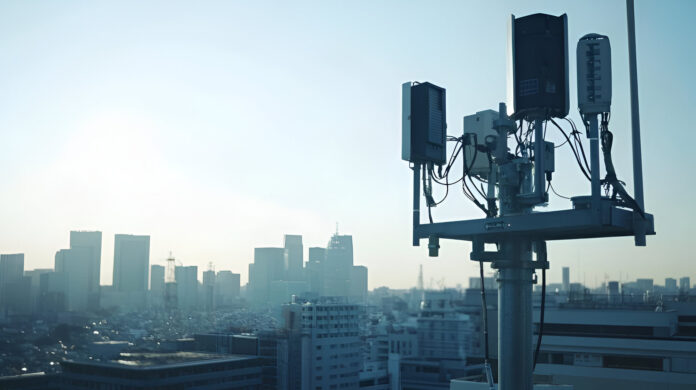Urban air quality is a critical concern globally, impacting public health, environmental sustainability and economic productivity. In Africa, monitoring pollution levels is essential to understand the impact of urbanization and industrial activities on air quality. Remote sensing technology offers a means of tracking pollutants and assessing air quality from a distance. The consequences of air pollution are dire, affecting not only human health but also urban ecosystems.

Dr. Bas Henzing, the Head of Climate & Air Quality Research at the Netherlands Organization for Applied-Scientific Research (TNO), emphasizes the significant role of remote sensing in tracking urban air pollution and air quality. He explains that, “Remote sensing plays a crucial role in monitoring urban air quality and pollution levels. By using advanced technologies, we can track where and when people are exposed to poor air quality and identify the sources responsible. This approach allows for a targeted and health-oriented strategy to improve air quality in cities.” Henzing Continues, “Remote sensing helps us measure these pollutants through various methods. For example, mobile measurement campaigns and large-scale sensor networks provide detailed data on particulate matter and gases. Additionally, citizen measurements contribute valuable information, creating a high-density network of data points.”
Without physical contact, remote sensing utilizes various platforms and sensors to monitor air quality from a distance. These platforms range from satellites orbiting Earth to drones and aircraft flying at lower altitudes, each offering unique advantages and perspectives. The sensors themselves utilize diverse principles to detect and measure different air pollutants.

According to Santiago Iraburu, Sales Manager for South America and Africa at Kunak, “Remote sensing has become an essential tool for monitoring urban air quality and accurately measuring pollution levels. Advanced sensors provide reliable and real-time data on atmospheric pollutants like particulate matter (PM2.5, PM10), nitrogen dioxide (NO2), sulphur dioxide (SO2), and ozone (O3). These technologies are crucial for continuous monitoring in urban environments, identifying areas with high pollution levels, and providing detailed information for decision-making.”
How Remote Sensing Monitors Air Pollution Levels
Remote sensing employs several processes to monitor urban air quality, turning complex data into actionable insights. Here are the diverse applications of remote sensing in monitoring urban air quality and Pollution Levels:
Satellite-Based Remote Sensing: A Broad Perspective
Satellites equipped with specialized sensors offer a powerful means of observing air pollution across entire cities and even regions. These sensors measure the spectral signatures of atmospheric pollutants, allowing scientists to quantify their concentrations.
Henzing States, “Satellite imagery, providing an overview of air quality over large areas or detecting pollution hotspots, and drone-based measurements, which offer flexibility in monitoring specific locations.” He further emphasizes, “We are a leading research organization, we have extensive expertise in remote sensing technology development and implementation.”
Aircraft and Drone-Based Remote Sensing: High-Resolution Detail
While satellites provide large-scale monitoring, aircraft and unmanned aerial vehicles (UAVs or drones) offer high-resolution data at a more localized level. These platforms can carry a variety of sensors. As Iraburu says “These sensors enable the generation of early warnings about dangerous pollution levels, which is fundamental for protecting public health. By integrating with accessible platforms, the data can be visualised by citizens, promoting greater awareness and participation in air quality management within their communities.”
Data Integration and Analysis
In monitoring air quality, data from satellites is often combined with information from ground-based observations. These data sources, researchers can gain a more accurate picture of air quality. Various models, like ensemble neural networks or convolutional long short-term memory (ConvLSTM), analyze this data. They assess the correlation between satellite measurements and air quality indexes, guiding pollution control strategies effectively.
“Air quality monitoring systems offer high-precision measurements even in complex contexts such as high-traffic areas or industrial zones. This capability is vital for managing air pollution-related emergencies and developing public policies aimed at reducing pollutant emissions,” asserts Iraburu.
Real-time Air Monitoring
Real-time urban air monitoring and pollution assessment is a critical tool in the fight for cleaner air. The technology provides up-to-the-minute data on pollutant levels and empowers decision-makers to implement effective interventions, informs public health strategies and facilitates a more informed and proactive approach to managing urban air quality.
As Henzing Highlights, “By combining data from different sources, we are establishing an integrated weather and air pollution modeling service to generate quantitative assessments of climate vulnerability. The service aims to support national adaptation plans, industry policies, and community resilience initiatives by providing real-time and predictive data on climate-sensitive parameters such as heat stress and air pollution.”
Additionally, as technology continues to advance, the expansion of real-time urban air monitoring networks will become increasingly vital for building healthier and more sustainable cities.
Case Studies: Innovative Assessment of Climate-Sensitive Health Risks in Kenya
The World Health Organization (WHO) consistently highlights the detrimental effects of poor air quality, linking it to respiratory illnesses, cardiovascular diseases and even cancer. Several case studies illustrate how remote sensing has been effectively employed to monitor and manage air quality in urban settings. One notable example is a study conducted in Kenya by TNO, which outlined an integrated approach to assess population health risk from two common climate-related health hazards: heat and air pollution.
The team indicated that, weather (heat) and air pollution data can be modelled and integrated to assess heat stress and pollution exposure across the area of interest, in this case, counties in Kenya to support quantitative climate vulnerability assessments, including to identify vulnerable population subgroups and preventative measures. Such innovative assessments provide actionable insights for stakeholders and health officials.
According to Elena Villalobos Prats, ATACH Secretariat Lead, “This innovative assessment of climate-sensitive health risks in Kenya is a significant contribution of knowledge to the Alliance for Transformative Action on Climate and Health (ATACH). Over 90 countries and areas in the ATACH have committed to building climate resilient health systems.” She further states, “Vulnerability assessments and health adaptation planning are key steps in this process. Through the case study developed by TNO, countries are now able to learn from the practical insights gained in Kenya, which are vital for advancing our collective efforts.”
Future Directions in Remote Sensing for Air Quality
The future of remote sensing in air monitoring looks promising. Researchers are developing new methodologies and technologies to enhance data collection and analysis. Cleaner technologies for remote sensing equipment are being explored, aimed at reducing urban air pollution effectively.
“Technological advances in air quality sensors are playing a decisive role in improving environmental management and protecting public health, contributing to the creation of healthier and more sustainable cities,” concludes Iraburu.
Additionally, partnerships between technology providers and urban planners will become critical in developing sustainable air quality management practices.



